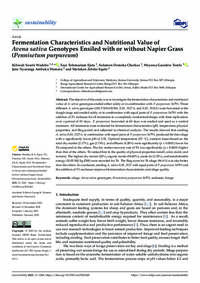Fermentation Characteristics and Nutritional Value of Avena sativa Genotypes Ensiled with or without Napier Grass (Pennisetum purpureum)

Authors:
The objective of this study was to investigate the fermentation characteristics and nutritional value of A. sativa genotypes ensiled either solely or in combination with P. purpureum 16791. Three different A. sativa genotypes (SRCPX80AB2806, ILRI_5527A, and ILRI_5526A) were harvested at the dough stage and ensiled solely or in combination with equal parts of P. purpureum 16791 with the addition of 3% molasses for all treatments in a completely randomized design with three replications over a period of 45 days. P. purpureum harvested at 60 days was ensiled and used as a control treatment. All treatments were evaluated for fermentation characteristics (pH, temperature, physical properties, and flieg point) and subjected to chemical analysis. The results showed that ensiling A. sativa ILRI_5527A, in combination with equal parts of P. purpureum 16791, produced the best silage with a significantly lower pH of 3.52. Optimal temperature (25 °C), nutrient losses based on the total dry matter (2.17%), gas (3.74%), and effluent (4.28%) were significantly (p < 0.0001) lower for T6 compared to the others. The dry matter recovery rate of T6 was significantly (p < 0.0001) higher than that of the others. T6 ranked first in the quality of physical properties (smell, color, mold, and texture). The highest dry matter (24%), organic matter (96.80%), crude fat (3.32%), and metabolizable energy (10.05 MJ/kg DM) were recorded for T6. The flieg score for T6 silage (96.6%) was also better than the others. In conclusion, ensiling A. sativa ILRI_5527 with equal parts of P. purpureum 16791 and the addition of 3% molasses improved fermentation characteristics and silage quality.
